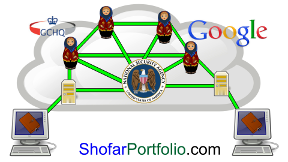|
||||||||||||||||||||||||||||||||||||||||||||||||||||||||||||||||||||||||||||||||||||||||||||||||||||||||||||||||||||||
|
|||
In the second decade of the 21st century the cloud is the rage. Individuals and corporations are turning to the cloud as a place for data and computing resources. While the cloud is simple and convenient, there are issues that make the barn model a better choice. Often when a farm family talks about the barn on their property they refer to “my barn”. The word to focus on is “my”. A farmer will put their equipment, their animals, and their stuff in their barn. It may be a really nice one or about to fall over, but it is their stuff in their barn. The farmer owns the barn and the stuff in the barn. Cloud users have no ownership in the datacenter and often give up ownership of their data. Large players like Google put data centers strategic locations like The Dalles in Oregon where they are close to the multi-megawatts of power they need. Iceland promotes itself as an ideal location for data centers since cooling comes cheap. Then we have the oddities like the massive Utah Data Center where a colossal amount of data goes in, but not so much comes out. Datacenters typically have numerous connections to the Internet, multiple power sources, and backups for everything. Their history of reliability is a pretty good one, but after suddenly going offline none of the datacenters in the twin towers were restored. Reliability is only one part of the equation; data ownership is a larger concern. We know the cloud, but what is the barn? The barn model is to put computers in offices, homes, and literal barns instead of datacenters. This is a model of highly distributed hardware ownership, but will raise concerns about reliability. The barn model can use much cheaper computers with much lower overhead. By addressing the reliability with software the barn model could contend well with the cloud model. Toilet paper makes a good analogy. With a high quality paper, you use few sheets; with lower quality paper you use more. In the same way data is reliable in a single datacenter, and perhaps just as reliable if distributed to multiple barns. If we apply the RAID (Redundant Array of Inexpensive Disks) approach to the barn model (RAIB doesn’t sound too catchy) then we may find a superior solution than the cloud. The datacenter uses expensive hardware for reliability. The barn model uses software to achieve the same goal. This can be done by pieces or with a comprehensive solution. ShofarNexus and the suite of related services is that solution. Finding the barn with ShofarDomain Step one is to find the data, whether it is a website, email, or any other kind of data, the URL must connect us to a working computer. ShofarDomain’s rootless technology not only decentralized control of domains, its resolver works to allow us to find the working barn. For example, let’s assume that ShofarPortfolio.com was hosted in three different barns, one in the US, one in Latvia, and one in South Africa. For a browser to make use of the website it must connect to a working server. The resolver can determine which of the three is operational and from those use other factors to return the IP address to the browser. This allows us to the IP level of communications protocols to provide reliability rather than specialized and limited access lower levels. This puts the software to control this in the user’s hands, not the communications providers. Distributing the data It is good to be able to find a webserver, but we first need to get the data to the server. ShofarNexus uses peers and mirrors to reliably distribute data. Simply put a peer can be written to and read from, while a mirror is read only. Mirrors are the simplest to understand in that they are merely a copy of the peers. Their purpose is typically to reduce the load on the peers but may be for other reasons, such as immutable websites that can be replicated freely. Peers can be two or more computers where any can be used to enter data. The peer is then responsible to distribute the data to the other peers. Writing a particular piece of data can result in all of the peers receiving it, most of the peers and therefore it is authoritative, or some of the peers such that the user must be informed that the data is conditional until the other peers are restored. Distributed business model As a user who wants to have a hosted website or store data you need to be able to find providers. A provider must be able to announce the availability of their offering and it capabilities. The Matryoshka model gives insight on how to do this for all kinds of services. For someone to operate a Matryoshka Node, they load the software on their computers and tell it to run. The computer will then announce to the “.Matryoshka” Top Level Domain that it exists and is ready to participate. Matryoshka nodes are globally reconfigured every hour and new nodes can be added without an approval process. Similar techniques can be used to announce available storage, computing power, or other services. The objective is no central authority, no multi-level marketing, and no detailed knowledge on the provider’s part. If a provider goes offline, temporarily or permanently, the global system stays operational and no data is lost. Bringing the barn to your home or office For the barn model to be effective a comprehensive solution needs to be built that is based on the Internet standards. It must allow for distributed ownership of computers and easy entry into the fray without first acquiring a lot of technical knowledge. It must work well with and in spite of cloud based solutions. We propose ShofarNexus, which includes ShofarDomain and ShofarPortfolio as the comprehensive solution to the barn model. |
|||
|
|
||||||


